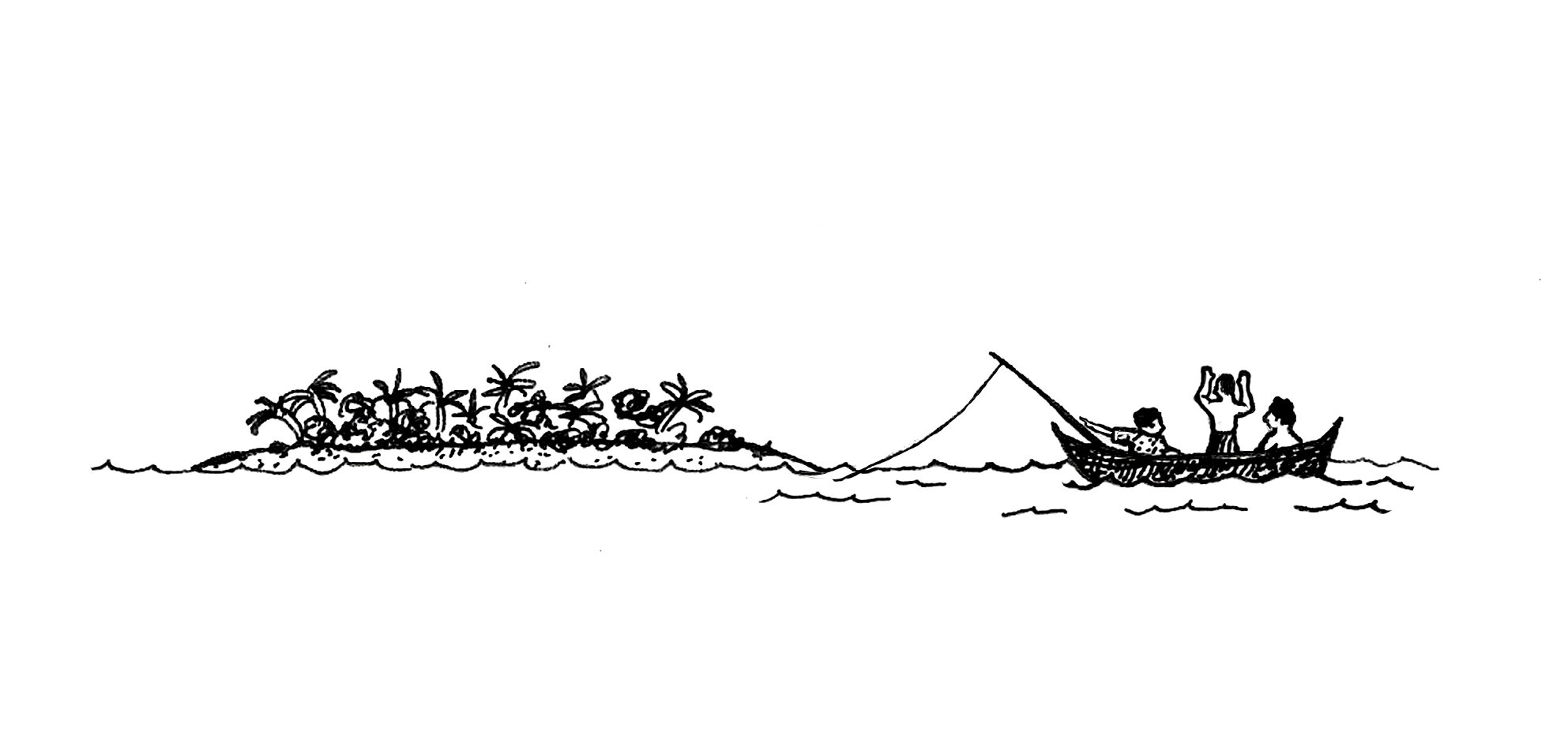Loaroab
Told by Maggie Tadog on Fedrai Island, Ulithi Atoll. Translated by Libertus Mandou.
Fiyong le ila sihasi mo wol, Fedrai, le Maggie Tadog mele ye fiyongo ngal gich
This is a story about the origin of Fais Island, which neighbors Ulithi Atoll and is where Maggie Tadog was originally from. It sets the stage for further discussion of Clan connections and ties. Fais is a mountainous volcanic island where there is space and fertile soil to grow food, by contrast with a low-lying atoll with poor soil like Ulithi.
English
Ulithian
Maggie Tadog began this story with an introduction that became the Foreword for this booklet.
Now I’m going to tell you a story. This story is about three brothers and their mother.[1] Loaroab had three sons. The youngest son was named Motigtig. She raised her sons until they grew up. Each day, the boys went fishing while Loaroab set out to gather local food.[2]. She would walk to the edge of the reef, and upon arriving, count the waves – one, two, three, four – and disappear underwater to appear on another island, the island of Fais. She always brought back a lot of food, for the island of Fais had abundant local food. She brought back ripe bananas and all varieties of local food. She went back and prepared food before her sons returned from fishing.
The sons began to wonder where all the food was coming from since there was not that much food on Losiep, the island where they were living. They had fresh food and fish every day. One day, the two older brothers went fishing while the third stayed behind to investigate where their mother had been getting all the food from for all this time. Only this time, her son was there to witness it. He listened to the words Loaroab said before she disappeared. Loaroab reappeared on Fais, turned herself into a starling, and started eating ripe bananas. When she saw the son, she knew right away that it was her youngest son. No male had ever come to this island of food[3] before. She called him, and she told him she was going to die because it was taboo for him to have observed her there. Loaroab died, and the son dug a grave and buried her under the banyan tree where she had told him to lay her to rest. He went back to his brothers.
The three continued to go out fishing, but now instead of fish, the youngest son was pulling up pots of well-cooked local food prepared by their mother. This went on for some time. One day while fishing, the youngest son’s hook got caught on something. He pulled and pulled. His brothers helped him pull until finally an island came to the surface. This was Fais island. (There was and still is a place on Fais called, Luu’wa,[4] where the canoe was landed.)
When the island surfaced, the brothers started arguing among themselves about which of them was to own the island. Finally, the youngest of them decided that they should go to their mother’s grave to ask her, and they all agreed. The oldest son went first. He took the stem of a coconut frond and tapped on her grave calling, “Mother Loaroab, oh Loaroab! Whose island is this?” He got no reply. The middle brother did the same and also received no answer. When Motigtig, the youngest brother, tapped and called out there was a response: “This island is yours, my dear son.” Upon hearing this, the other two brothers grew so furious that they swam from the island, and the youngest son was left behind.
It is said that the coconuts from this island had no husks. One could simply pick the coconut right off the tree and drink from it. It is also said that the fruit of the noni trees there had no seeds. Fais back then did not have a harbor. Perhaps it was Motigtig who made a harbor by burning the corals down during low tide to make an area for boats to come in. While he was working on the harbor, three spirits arrived from an island called Metang. These three spirits were brothers and large in appearance like giants, and they swam to Fais. One was called Songsongmal. The second was called Chimagar, and the third, they say, was called Morowa.
These three giants scared off Motigtig, who fled Fais island. The three giants settled the island and divided it into three villages. Elthow was the western village. Luchuchuy lay in the middle, and Falyew was the easternmost village. Each of the giants occupied a village. In the past, there was a celebration in honor of this event, but it is not observed nowadays.
This is how one of the giants met a woman named Lealgeech. One day, the three giants were standing on the side of the island with the harbor. They were looking out all the way to the opposite side of the island when one of the two giants on either end of the island first spotted her. They decided, however, that the giant living in the middle should have her as his wife because he looked the most like a chief. Some people believed that the woman came from the Clan of Rats.[5]
The End.
[1] This is a story about the origin of Fais that is also told by elders on Fais. There is a petroglyph of a canoe on Loosiap that is said to be the canoe from this story. The version of this story on the Pacific Worlds website (called The Origin of Fais” has two of the spirits from this story as the names of Motigtig’s older brothers.
[2] “Local food” means food that grows on land, as opposed to food from the ocean which here is called “fish.”
[3] Fais is a mountainous volcanic island where there is space and fertile soil to grow food, by contrast with a low-lying atoll with poor soil like Ulithi.
[4] Wa means canoe. Lu'waa is referring to inside the vessel, as opposed to Lal Fraf, which would mean topside, the platform area on the outriggers. Recall another important piece here, in the political system, the organizational chart is like a canoe. So Lu'waa here is referring to this area being also the "Bbul" or main hull of a canoe compared to the outrigger, which does not have an inside hall to carry people. But the outrigger is still rather important to keep the canoe from tipping over. It’s an early education of hierarchy of the three villages in Fais and its important connection with Ulithi (through Losiep, the traditional platform named "Bugat Laplap") (Magul).
[5] This is setting the stage for further discussion of the Clan connection and ties. This woman is coming from another place, and all three Giants are looking out to sea. It's talking to us about how the people of Fais have strong ties to others outside of Fais because it's only one island on its own. So they welcome visitors as a way of creating relations outside of Fais. The Clan of Rats still exists in Chuuk and the Eastern parts of Micronesia. So this could also be an explanation of that wide spread of clan ties into the Chuuk area. (John Rulmal)
Ilae ible yewal ngalugmi sew fiyaong. Sew fiyaong le fiyaongel soelmoel bisbis mo mala sealer. Mala sealer ilae Loaroab. Yemel soelmoel tarmal l’oal. Metawe hartal yarmat ilae Motigtig mala idal. Yesa hafoglar dah yodwe rela paeling. Iwe resma loag fetae halaer, ngo iy yesla faeg gelaer mongoy le yema daer way ngachel taed sa suy, sa soer boa, “Yoad, riuy, yael, faeng,” sa bidiy fael yaelulael, sa bidiy wol sew fuluy le rema soer boa Fais mala idal. Yela budoh ngo ye choloap, choloap mongoy. Choaloap yuuch le yesa maach, choalop mongoy wol iy fuluy lae ible kaek gal mekawe l’oal, sabida, sabudoh faor bla tefael mekawe mo irel fetae.
Iwe ngo sa yoor haelaer. Yiir rema luwaley hare ma budoh mekawe haelaer mo iya, bo toar mongoy wol iy fuluy we rema mel iyang. Rema mel Loosiyap. Iwe seral ngoa reloah, ngo rebla tefael ngo yor haelaer mongoy.
Ralawe seral saloah iwe rumael, samel diy iwe semael, sa moal, sa komahoy moeloe sealer. Sa choalop ral yal yal yi foefaoru, ngo seral mele matawe sa moal, sa komagoy. Sa taelngae moeloe iy ye soer, sa loah yi moelwe sil ngo iy sa wol faoru, sa wol bidiy wol iy fuluy we, sela mel boa semael mwiliy sela momongoy moa irel sew yuuch le sa maach. Moeloe sealer ye kal loag choeg le ye wiri ngo ye gulae boa moeloe loal boa toar mael wol fuluy we. Tema towas mongoy wol fuluy we. Iwe yesa fusnguy moeloe loal, sa kaengaluy boa budoh. “Igla le ible mes. Ible mes bo gel hosa wiri yey.” Iwe sa kaengaluy loebos la yebla lebae mo iyang, le fael seha gulyoa. Sa mes imoelwe sil, ye sa kilngiy moeloe libal, sa leba, sa tefael dah irel mekawe bisil.
Iwe resma loah fetae ngoa mekawe bisil reble yaefyef yig ngo iy yeble yaefyef dag rowal dipchig, iwe ngoa moeloe sealer mele yal hafaor mekawe. Sa loah loah ye la seral sa moch laoh yaw we yal, sa budoh yaefsiy yaefsiy boa sa moach. Resa yedmaegly resa yaefsiy, yaefsiy ye la lah dah ngoa sew fuluy yi moelwe ngo ilae mele, Fais. Ye mel soelboes le rema soer boa “Luwa” mala idal mo wol Fais. Ye mel iy wa we war iyang. Ibe moeloe reble chaep yar fedeg iyang. Semael ngoa ye soer boa yi mele fulyal fuluy we. Ngo iy yesa soer boa iy mele fulyal. Ngoa iy yesa soer iy mele fulyal. Ngoa iy mekawe bisil sa soer boa fulyaer. Ilae ngoa siyae loah irel moeloe silaech sibe kasiyae. Resa loah, yesa hasi sew paley sa waduydiy wol pey we sa soer boa, “Loaroab, ho Loaroab! Faeluyel itey faeliyei?” Metawe semael mele metamwow ngo yete maliliy. Metawe semael sawol faoru ngo tewol maliliy. Metawe haloelmoeloel yarmat sa faoru ngo yesa maliliy.
“Faeluyem choeg Mawuyecha.”
Ilae moeloe reble seg yi maekawe bisil resa yaef laoh lemdaw. Ngo yi mele sela meldiy.
Re soer boa wol luu wol fuluy lae ilae toar piyoeloal, hobe budoh choeg, sa gilsiy, sa yulmiy. Iwaal loel toar faesul. Iwe sa paey wol iy fuluy we. Ngo toar dawal iy Fais. Iy mele (Motigtig) ble moach budoh faor daaw le ye kekatawasiy le – tugula hare ma fisgiy hare ma fedey mele mad ngoa iy yesa buyoey fisgiy hare meda. Yesa foefaoru moeloe ngoa la budoh sibis yalus le re budoh mo wol sew fuluy le rema soer boa Metang. Re palingling wululul remtaeng kawe yesla yaefdoh wol iy fuluy we le re soelmoel semael le rema soer boa Songsongmal, semal le Chimagar, sewol re ma soer boa Morowa.
Ikla rechoakla ye daer Motigtig mo wol Fais iyang. Iwe yir mele resla meldiy wol fuluy lae. Resa faoru fuluy la, sela suluw haling mo iyang. Semael sa mel mo Lodow, semael mo Loechoechoe, semael mo Faelyow. Yor sew bong le bungur. Yor mekla bungur le yebe hola ngoa mekla yarmat ma faoru le re ma gublae muswe ngo igla tayor mele rema faor ngali. Semael yir mele ye wiri semael faefel le re ma soer boa Lealgeech. Re su metar ngo resa kal wey yilug. Metla ye mel mo setab fuluy mele ye wiri faefel lae. Resa kapta fengali bo reble ngaley matla choechoel fuluy boa sa wululul moebe yi mele yar tamwol boa riil. Yor toet yarmat le re soer boa ye budoh mo irel Dao la yal Geech.

